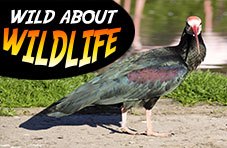South Africa is home to many Ibises, but the least common is the Southern Bald Ibis. These are large birds who populate open grassland and semi-desert areas in the mountains of Southern Africa, and are in fact endemic to this area. There are over 150 colonies in the country, concentrated in the NE Free State, Mpumalanga and the KwaZulu-Natal Drakensberg.
Ibises like high altitudes of between 1,200 and 1,850 meters, nest on cliffs and feed in large flocks.
You will notice they are generally dressed in a glossy, dark-green feathery outfit streaked with a combination of iridescent green, violet and bronze. The Southern Bald Ibis has a whitish, naked head with a small red crown, and a long red bill which curves downwards. Its featherless and wrinkled face is what gave the bird its Latin name, Geronticus calvus, meaning “bald old man”.
Social But Quiet Peckers
Southern Bald Ibises build nests on cliff edges and travel in large groups of up to 100 birds. They’re not very vocal and only occasionally produce a high-pitched gobbling sound, usually when in a breeding colony. Whilst grounded, you’re likely to see them taking a quick stroll pecking at the soil for caterpillars, beetles, grasshoppers and earthworms. Ibises also like to feast on rodents, small reptiles and birds. Normally once they have been found already dead. As living prey such as insects is easier to collect in recently burned or mowed areas and cultivated pastures, these are the ones Ibis will frequent while staying clear from tall grasses and marshy areas which make hunting difficult and allow their pray to hide easier.
Living prey such as insects are easier for the Ibises to scoop up out of recently burned or mowed cultivated pastures. These are the kind of prey the Ibises prefer to target. They try to steer clear of marshy, tall grassy areas which make hunting their own prey more difficult for them, whilst making themselves more vulnerable to being hunted by other predators.
The Young, Well Looked After
After a male Ibis finds an appropriate spot for the nest, he’ll claim and aggressively protect it when needed. Only after finding a cozy spot, will he then bring a lady home and proceed to collect sticks and grass that she needs to construct a nest. She will lay two or three eggs during the period of late Jul to mid-October. Her eggs take roughly a month to hatch. Mum and dad feed the chicks via regurgitation for about a week, ensuring that their babies remain hydrated and nourished. It takes the young about 40 to 50 days before they are able to fly, though they’ll keep depending on their parents for food a little while longer. As far as life expectancy goes, Ibises can reach an age of 10 to 15 years old when living in the wilderness, but can also live for up to 30 years in captivity.
Listed as Vulnerable Thanks to Humans
The species are now listed as vulnerable, but are thankfully not in immediate danger of extinction. Their eggs are prone to being eaten by snakes and birds of prey, such as the Jackal Buzzard, Black Eagle and Pied Crow but the real enemies are in fact human beings. In the past, these birds were used for traditional healing purposes by the Zulu, as food for Boer farmers during the wars, and later on were also hunted for their feathers and meat. These birds are currently protected, yet are still being hunted. The fact that Karoo vegetation is continuously Spreading so widely, means an additional element that is not working in their favor.




